Writing Advice:
A case study by Australian author, HR Kemp, sharing the experiences of self-publishing her novel. From working with an editor, to preparing her book's interior, to publishing it on multiple platforms, to marketing and selling her work, this post explains the entire process and the amount of work involved.
Quick links on this page:
About 18 months ago, Australian author H.R. Kemp wrote a guest post for my website about her experiences with Inkitt, the world's first reader-powered book publisher.
You can read H.R.'s previous post here.
Since then, H.R.'s situation has changed. Her book, Deadly Secrets, was not selected for publication on Inkitt's platform, so she decided to self-publish her novel.
This post is a continuation of H.R.'s experiences after Inkitt.
H.R. has kindly written an in-depth account about many aspects of her self-publishing journey, including:
Like H.R.'s last article, this one is candid, brutally honest and shares a plethora of information and advice, all based on real-life experience. I hope you enjoy reading the post as much as I have enjoyed preparing and presenting it here.
Hi. I write Australian political conspiracy mystery/thrillers as H.R. Kemp and my blog post about using Inkitt was featured on Chris's website in March 2019. Now, a year and a half on, I’ve self-published Deadly Secrets and this is the story of how I got from there to here.
My experiment with Inkitt didn’t result in publication and after keeping Deadly Secrets on the Inkitt site for just over a year it was time to make a decision. I’d put in a lot of energy and time to promote and it felt strange working so hard just to get people to read my book for free.
I touted for reviews from friends, other authors and Inkitt readers and slowly built up 30 reviews, 26 of them 5-star and the rest 4-star. I shared it regularly on the Facebook groups Inkitt recommended but, despite my efforts and the great reviews, my analytics only reached 58% (meaning there wasn’t enough data to decide if it would be published). I was exhausted and discouraged by how hard this felt.

When another Inkitt author, Barry W Litherland, whose books I enjoy, reached 100% analytics, I almost held my breath. He had great reviews, he’d gained a large following on the site and I expected this would be his big chance to be traditionally published.
But nothing happened. There was no publishing contract offered. In fact, there was no acknowledgement at all. He was eventually told that the analytics were only a guide and were not a guarantee of anything. We’d misunderstood how it worked.
For me, the resulting disappointment meant I had to decide what to do next. Inkitt had been useful. The readership and other authors were like beta readers, offering comments and suggestions, which had helped me to edit my novel.
To be honest, I still wondered if self-publishing was a real option. Did I need the validation of a traditional publisher? I had spent years submitting (and wasted time following the original rules of one publisher at a time) but the only feedback I had was that although my novel was well-written and had a good plot, they didn’t feel it fitted within their genres and they were not sure they could market my book.
I’d doubted myself for a long time, wondering if the rejections had meant my book was not good enough, but then I’d earned great reviews on Inkitt. I played with the idea of self-publishing but the thought of marketing and promoting were daunting (and, if I’m honest, they still are.) After-all, how would my book attract readers amongst the 7M books in the Kindle store (and the 88,000 books added every month on Amazon alone)? If I couldn’t attract readers when my book was free, how was I going to attract readers when they had to purchase a copy?
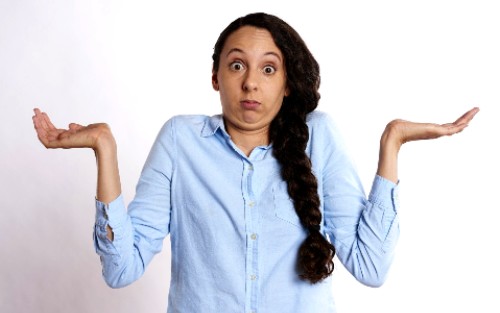
While I pondered these questions, I submitted 3 short stories to competitions and magazines. I polish and rewrite short stories in bursts and don’t submit them often. In September 2019, I was excited to learn that one of my short stories had been accepted for publication in the UK Writers’ Magazine (October edition).
Imagine my excitement when a second short story was accepted, this time for an anthology, When Stars Will Shine, and I was being published alongside talented and established writers. (This UK anthology raises money for the Help for Heroes charity.) Suddenly I felt my writing was being validated in a different way and I started to believe that maybe I could publish my book.
The promotion and marketing process for the anthology was a timely learning experience. It laid the ground work, helping me to understand how it could be done. The bonus was connecting with a whole new group of writers and readers.
The successes gave me a confidence boost so when my third short story was accepted for publication in the January 2020 edition of the Writers’ and Readers’ Magazine (formerly Writers’ Magazine), I decided I was ready to take the plunge into self-publishing.
I’d resisted the idea of self-publishing. It felt almost too hard and there still seemed to be a stigma associated with not being accepted by a traditional publisher. I worried about the expertise, time and effort required. I’m a slow writer, so time directed away from writing is an issue. However, it was becoming increasingly clear that if I wanted to see my novel in print, I would have to self-publish.
Self-publishing offers the ability to maintain creative control which is appealing and I’ve noticed that traditionally published authors often have to market and promote themselves anyway. I researched the hows and whats of self-publishing and that helped me decide what professional help I needed and how much it would cost.
Firstly, I was determined that my novel should look and feel professional. That meant being prepared to pay professionals to edit the manuscript, design a cover and maybe even format the book for eBook and print versions.
I dithered and wondered if I could justify the expenditure when I couldn’t be assured of recouping my costs. However, a friend set me right. She pointed out that many people spend money on hobbies they never expect to recoup and, if I gained pleasure from writing and seeing my book in print, it was no different. She was right. After so many years learning, writing and rewriting, I should be prepared to spend some money to achieve the quality product I could be proud of.
I finally selected three editors from the recommendations of author friends and Facebook groups. The local editor didn’t respond to my emails and the USA editor’s quote was too expensive once I factored in exchange rates. The UK editor’s quote was reasonable and she was willing to quote in AUD. (She’s based in Ireland and charges €7.50 to €10 per 1,000 words, based on the level of work). My quote was at the lower end since my manuscript had had extensive self-editing and beta reader feedback.
She provided a sample edit and we emailed each other to discuss the process and what was needed. We had a compatible approach and I felt confident that she would do a good job.
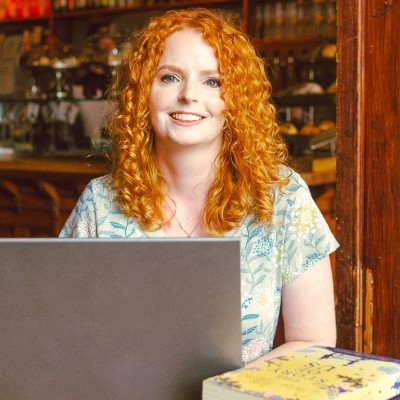
Amanda Ní Odhràin from Let’s Get Booked
Amanda Ní Odhràin from Let’s Get Booked allocated time to edit my novel and I was thrilled that she also designs book covers and formats manuscripts into print-ready and eBook-ready files. This provided a seamless service and we were a comfortable fit.
By this stage, I hadn’t read my book for some time, so I had a fresh perspective. Editing involved three run throughs, the first being the most extensive and it picked up little issues and applied a reader’s perspective. I wrote the bio and acknowledgements for the back of the book, including contact information, while Amanda prepared the copyright page.
Although a few of my author friends formatted their own manuscripts and insisted it wasn’t hard, after setting up a website and dealing with other technology issues, I decided to pay for Amanda to format all the versions. Her fee seemed reasonable at €0.50 - €1.00 per page (Times new roman, 12pt single spaced in word).
To distribute widely I needed an ePub, a Mobi file and three print versions (one for Amazon, one for the IngramSpark (IS) and one for the local printer). UK and USA use inches, Australia uses millimetres and all the book sizes varied enough for each to need a different format. I had thought I could select one size paperback for all, but that was definitely not the case.
The cover design process was interesting and enlightening. I had put together a basic cover for the Inkitt entry, but I knew I couldn’t rely on my design skills to develop a professional looking cover that fitted with my genre.
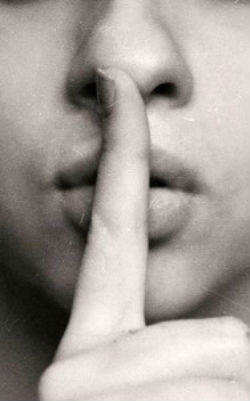
H.R.'s Inkitt Book Cover
Amanda had a questionnaire which focused my thoughts on the important questions. I researched top selling thriller books and saved screenshots of the covers I particularly liked, adding an explanation of why.
At times the covers I liked were totally different, some bright colours, some black and white, so I had to be clear about what attracted me to a specific cover. It made me pay attention to the title font, colour, and placement, the image style, the layout and even the mood. I’d never looked at covers in such detail before.
Amanda developed four design concepts:
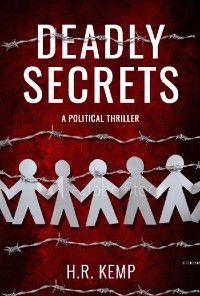
Red cover concept 1
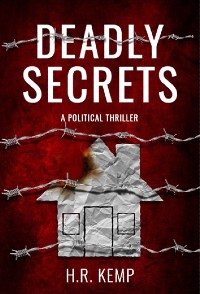
Red cover concept 2
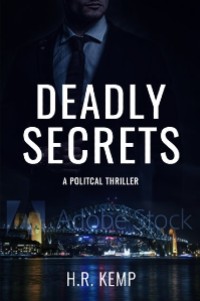
Blue cover concept 3
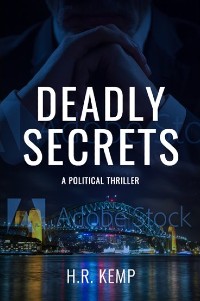
Blue cover concept 4
I knew which one I liked best, but I wasn’t sure if readers would agree. I posted the four designs on my Facebook and on several Facebook groups and asked for feedback.
I was stunned by the response. I’d expected a few comments but I got hundreds. Just as well there was a clear winner. I also asked friends and family and took the four concepts into my local bookshop to ask the staff what they thought. That too was an eye-opener. They identified two of the design concepts as consistent with the thriller genre while the others were more crime-oriented.
Once I selected the design concept, Amanda refined and tweaked it until we were both satisfied with the final look. I know I couldn’t have designed such a stunning cover myself and at a quote of €150-200 for her design, I’m confident paying for a professional was worthwhile.
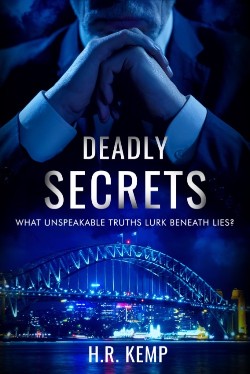
Deadly Secrets – final cover design
To complete the cover, I came up with a subtitle, wrote a blurb/description for the back cover and selected feature quotes from Inkitt author’s reviews. Even this caused me angst. I was worried about getting it right and making sure the blurb was doing the book justice. At least with an eBook, it’s easy to change, but with a paperback, it stays until the print run has been sold.
I sought feedback from author friends but in the end, I needed to just give it my best shot.
Now-a-days, it’s not considered necessary to have a paperback. It’s an expensive option but holding an actual book in my hand was important to me. However, I hadn’t realised just how many decisions were involved.
Firstly, what size (trim) book did I want? I’m not a fan of the recent publisher’s trend to print the larger 9.5 by 6.25 inch format. Instead I chose the 8.5 by 5.5 inch size for the Print on Demand (POD) books and the 210mm by 135mm (roughly 8.25 by 5.25 inches) for the local printer (their range of options weren’t the same). The book is almost 100K words, about 450 pages, so I couldn’t make the paperback too small but this size proves big enough to have easy-to-read formatting but not so big that it’s hard to carry around.
Page numbers must be in multiples of 16 so there are blank pages at the back. There were more choices to make. Pages could be crème or white and on different gsm (the thickness of the paper). The cover could be printed on different gsm artboards and be finished in matt or gloss.
I checked the paperbacks in my home library for guidance, but I couldn’t be sure of what I was looking at. Luckily, my local printer was super helpful. They print books for all the Australian traditional publishers and invited me to visit to talk through the options. The rep laid out examples to illustrate the differences and helped me select the options that suited what I had in mind.
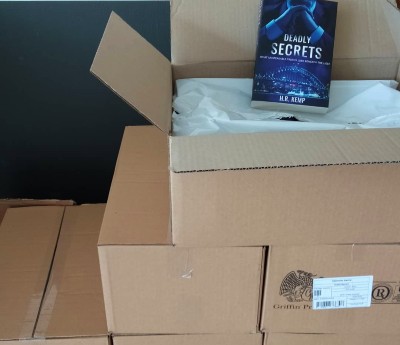
I had a print run of 200 books delivered to my home and it was cheaper than other printing options. I also really like the quality, look and feel of these books – the colours seem more vibrant and the cover doesn’t have that felt-feel that the PODs have.
I purchased my own ISBNs ($AUD88 for a set of 10 – plus $AUD55 for a new publisher) even though distributors will allocate a free ISBN for you.
Why?
Providing my own means I am the registered author and publisher of my book and the ISBN stays with my book regardless of any changes that I make to distribution channels. (Different countries have different fee structures. In Australia they are sold through Thorpe-Bowker and you can buy just 1 for $44 (plus new publisher fee) or 100 for $AUD480).
Buying 10 meant I had the necessary ISBNs for my Paperback, Mobi and ePub versions (each requires its own ISBN) and I can use the others for my next book or to create a large print version for Deadly Secrets.
I also made up a publisher name and a logo (Amanda charges €50-100, but my logo was included in the cover design charge).
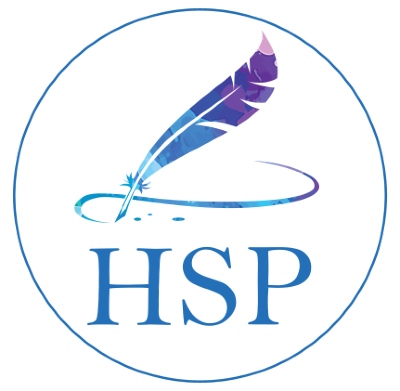
I think it gives the book a more professional feel.
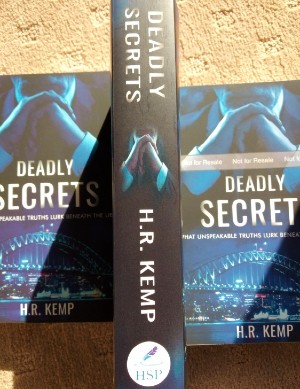
Many self-published authors are happy to be exclusive with Amazon for both eBook (Kindle) and paperback (POD) and it’s an easy option. Many also submit their book to Kindle Unlimited which makes the eBook exclusive to them.
As a debut author, I was keen for my book to be widely available and to reach as many prospective readers as I could. There are many different distributors, they take a percentage, and each has different levels of flexibility. I selected the following platforms for Deadly Secrets:
Initially, I intended to use IS only for the paperback distribution. However, I was enticed by their wide range of eBook options and I flirted with using them too, but, it became complicated.
They suggested I allocate a different ISBN to an eBook but that meant it doubled up on some platforms where duplicates were not allowed. I could only deselect Amazon and Apple books. IS didn’t allow deselection of any of the other platforms in their distribution list. It became a matter of choice and I removed the eBook from IS and am using them for the paperback distribution only.
D2D distribute eBooks to a number of platforms and you can select which ones you want. Through them, the Deadly Secrets ePub is available to Barnes and Noble (Nook), Apple Books, Tolino, and some subscription services and libraries.
They provide a single link which means the reader can access the book in whichever format they require from one page. I also have my author bio on their corresponding Books2Read site.
D2D or IS can distribute to Kobo but I was advised to go direct. That way I can access Kobo promotions and enlist my book in their subscription service (which is not exclusive).
I’ve found Kobo to be very user friendly, approachable and their team is happy to help. It’s refreshing to have a real person answer emails and questions. Their promotions have helped me to gain sales too.
You can see Deadly Secrets on Kobo here.
I uploaded both an eBook and paperback (POD) onto KDP. At first, I thought I couldn’t use the same ISBN for the paperback on KDP as IS, so although I uploaded the book I didn’t publish the KDP version straight away. But during the launch, I ran into problems (I’ll explain later) and after getting advice from ALLi (Alliance of Independent Authors) I uploaded the paperback on Amazon too, using the same ISBN. Now Deadly Secrets is available through both distributors and IS makes it available to a number of bookshops, retailers and libraries too.
One important thing I didn’t find out until later is that the three BISAC categories (Book Industry Standards and Communications) the KDP system asks you to select are not the same as those used on Amazon sites. In fact, Amazon has its own categories and they vary between the different sites, e.g. the .com uses slightly different categories to co.uk, or com.au; and the categories vary between the Kindle Store and paperback book site.
Using BKLNK, you can find the most applicable categories. I did the research, well after release, and when I had compiled my lists, I emailed a request to Amazon (from Author Central) to add these to my book. You are allowed up to 10 for each book and the more categories you can list (that are relevant) the more likely your book is to be found.
An example of a category string is:
Setting up an account with each of these channels was time-consuming since their requirements and systems vary. I could use my Australian tax file number (and this also accessed the lower tax rate in the USA, courtesy of the Tax Treaty) on all platforms except IS, who required me to register as a sole trader and supply a business number.
The uploading process was also time-consuming and at times frustrating, but having my books professionally formatted meant there were few errors to deal with. Each platform has its own guides to help. Just make sure you allow plenty of time. I set a release date that I thought had lots of leeway, and yet I only finished everything a little over a week before the release. (I contracted Amanda at the beginning of October 2019 and my release date was 31 March 2020.)
I’ve placed my book on the library register through the ISBN agency (Bowker Thorpe), IS and D2D. In Australia, I had to lodge a print copy (legal deposit) with the National and State Libraries too.
The final stage is to select the price. I’d previously seen lots of Kindle promotions for 99c, but I felt uncomfortable about offering my book at such a discounted rate. I know having a 99c or free book can gain wider exposure, but the royalties on eBooks are already very low. I hoped to recoup some of my costs even if I couldn’t earn it all back. Advice from author groups recommended setting a fair price based on how big the book is and what the genre usually costs and I followed that advice.
I also remember an anecdote from a friend who set up an aboriginal art gallery. He travelled to remote communities to buy art works to sell in his city studio. He set what he believed to be a fair price, which was cheaper than much of his competition. He told me one day that he’d overheard customers suggesting that his low prices made them worry that the artworks weren’t genuine. He raised the price, and he gained more sales. It seems counterintuitive, but perhaps a low price makes consumers think it is also lower value.
My paperback is almost 450 pages, it’s a big read and I was advised to set the price between $17.99 and $19.99. $3.99 for the eBook is at the cheap end of the range, but not a give-away. I listed my book for sale in all countries and amended the individual prices (after the automatic exchange rate adjustment) to end in a .99 or .50.
It’s worth noting that Kobo doesn’t expect books to be listed cheaply. Their promotions have more impact if the book is reasonably priced before it’s discounted. I have set the same price on all the platforms.
Once the files were uploaded, but before the book was released, I ordered a proof copy (both paperback and eBook) to ensure they didn’t require any last minute fixes.
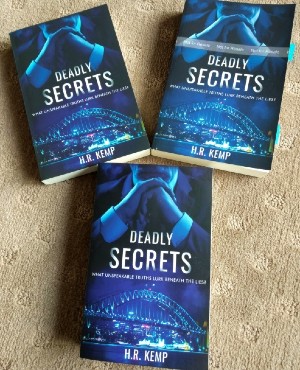
3 different print copies: Top L, IngramSpark POD; Top R, Amazon POD; Bottom, Griffin Press print copy
Once I was satisfied, I pressed publish and made it available for pre-order.
The process seems straight forward (in hindsight) but I relied on advice and help from many people. My self-published author friends were often on-hand and, as a member of author Facebook groups, I was able to tap into their knowledge.
I also joined two professional organisations:
They provide legal and practical advice, run courses and advocate for authors. They also have special deals with affiliate organisations which can be useful. My ALLi membership provided a code to load my manuscript on to IS for free.
There is so much to learn about being a self-published author and that is without the added strain and angst of bushfires ravaging my daughter’s property (luckily the house was untouched), a serious family illness requiring major surgery and a COVID-19 pandemic. It wasn’t hard to understand why I struggled to concentrate.
I’d dithered about having a physical launch or release party, given all that was happening leading up to the release, and then COVID made the final decision for me. Thinking about whether to have a launch or not made me realise that I often don’t stop to acknowledge my achievements, but move straight on to the next challenge. My family and friends encouraged me to stop and celebrate this time; we could use a reason to celebrate and, just as I decided that’s what I would do, it was no longer possible.
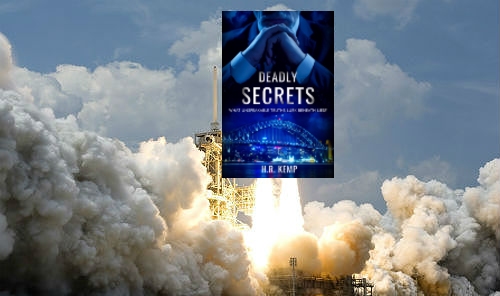
I wasn’t confident enough to run a live event on Facebook, or set up paid ads, so I promoted in Facebook groups, on my Facebook page, Instagram, and personal emails. I got off to a slow start and I stressed about not being totally prepared. All the advice suggests the launch should be a big bang. My website wasn’t completely ready, I didn’t know how to advertise on Amazon or Facebook or know all the ins and outs of promotion and marketing. The family illness and the fallout from the bushfires meant I needed to pay attention to other things besides my book too. Not only was I trying to come to grips with launching/releasing my first novel amongst these issues, COVID restrictions were starting to bite and there was no way of knowing what was ahead. I forged ahead anyway.
To add to my stress, on release, Deadly Secrets was priced at $57 on Amazon.au and all on-line Australian retailers. As an Australian author with a debut novel, I had expected Australia to be one of my main markets, but no-one was going to buy a book at that price. Because, at the time, I had allowed IS to distribute the POD to Amazon, their decision to source the book through IS UK meant the price reflected the exchange rate and shipping cost, and every other online retailer had followed suit. It almost brought me to tears and I had a few sleepless nights. All my hard work was being undone and there was nothing I could do about it.
I spent days emailing them, pleading, begging for Amazon, Booktopia, Book Depository and IS to source the POD in Australia and set the price correctly, but no-one was willing to help. That’s when ALLi advised me to publish my paperback on Amazon as well as IS. I’m not sure why it should help, but it worked. Luckily, it was already up on their system, so I only had to press publish and the price slowly decreased to a more reasonable level. But it got things off to a difficult start.
I’m still learning about marketing and promotion, and there is so much more to learn. The fact that Deadly Secrets didn’t fit neatly into the existing genres meant marketing or promoting this book would be complicated for me too.
I set up an author profile on Amazon Author Central and connected it to Deadly Secrets (and the anthology with my short story). Unfortunately, Amazon has a separate website in each country as well as separate author centrals. They are not linked. I had to log in to each country’s website and repeat the process.
To complicate things, if you are logged into one country and then try to access another, it doesn’t show you the correct data. For example, when I was logged into Amazon UK (and had forgotten to log out) I logged into the Amazon Germany website and couldn’t find my paperback. It was showing me only what someone from the UK is allowed to access, rather than what was there. It certainly was easier to add a bio on Books2Read (which is the Draft2Digital author page) and Kobo.
So far my promotion and marketing is not very sophisticated. I’m a member of many different Facebook reader and author groups, some of which allow promotion. Since I’ve built up contacts over time, I’ve gained some support from other members. The Inkitt readers and authors are also a strong support network, often sharing my posts and responding when I promote my book. I accepted all offers to guest blog and to date I’ve had eight shared on Facebook and one on Instagram. I don’t know if this translates into sales, but I have had sales in other countries and I put that down to the reach of Facebook.
During the COVID self-isolation phase, I wasn’t sure how I would get physical copies out to readers. I was lucky that some of our local bookshops were still operating (some delivering books to readers, others able to maintain a shop front) and when I approached them about stocking my book, three agreed to stock it on consignment. Since restrictions have been eased, Deadly Secrets is available in seven local bookshops and I’m happy to say sales have been steady. They seemed keen to promote a local author and were impressed with the professional look of my book.
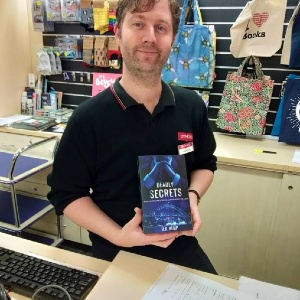
Andrew from Dymocks Bookshop in Glenelg
It takes a lot of time to sell the books through bookshops. I contact them regularly (or drop in to check if I’m nearby) to see if there have been sales. I deliver additional stock and send an invoice for sales as we go.
I’ve been delighted that friends and acquaintances have wanted to buy copies and their willingness to promote my book by word of mouth has helped with sales. Even my physiotherapist stocked copies at their front counter and helped to promote sales to their customers and Pilates class attendees. It’s been lovely having a network that has been so supportive. I’m also about to start doing author talks, so wish me luck.
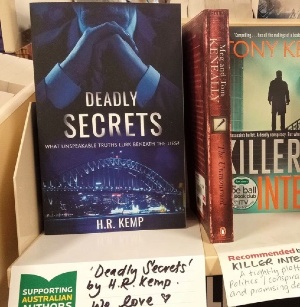
Deadly Secrets on the shelf in a bookshop
I’m not very proficient at technology, so setting up my own website was a challenge. I recently upgraded it to a custom domain, attached Mailerlite and a domain email address. If you feel inclined, perhaps you could check it out and give me feedback.
I hope to build a mailing list, but it’s a work in progress (and I need to figure out how all those components work, not to mention learning more about keywords and SEO so my website can actually be found).
Despite having more time during this pandemic, my concentration often waned. I managed to go for a daily walk along the beach (and you can see the photos on my Instagram), I completed several on-line courses, the latest an Amazon ads challenge, and I’m experimenting with ads both on Amazon .com and Amazon UK.
They are totally separate websites and have slightly different set ups, so it keeps me learning. Amazon has only recently added Australia and Canada to their advertising console and I’ve just set up my first ads on these sites. My efforts have resulted in a few sales, but fingers crossed I’ll work out the winning formula.
The other complicating factor is trying to fit my book into a genre. Just as the publishers predicted, my novel isn’t a neat fit. It’s not an FBI or CIA agent thriller which dominates the US Political Thriller genre. My political themes involve drama, intrigue, conspiracy and suspense, and my plot is about ordinary people being challenged to stand up for what’s right. There are no gun battles or car chases. I’m still searching to find the books that are similar to mine. All suggestions are welcome.
I’ve participated in three Kobo promotions and was thrilled that they generated sales. Kobo have recently expanded their subscription reading application to include Canada (previously only Belgium and Netherlands) so I’ve just signed up for that too.
As you can see, the promotion and marketing aspects can be time consuming and exhausting. I feel it’s been a steep learning curve and I’m not finished yet. I am hoping to find a way to limit the time element, especially as I need to work at editing and rewriting my second novel and prepare it for professional editing. Being a slow writer means I’ll never churn out books, but the advice of some is the best marketing and promotion is to write more books. I am hoping it gets easier as I go. We’ll see.
Between the release on 31 March and end of July, I’ve sold just under 200 books (35% eBooks and 65% paperbacks). This ratio may be a reflection of my reader profile.
Of the eBooks, approx. 16% have been sold through Amazon, 12% through Kobo and 6% through D2D (mostly Apple books). I’ve participated in Kobo promotions but now am also running Amazon ads, so we’ll see if that increases my sales.
Most of my paperbacks have been sold either personally or through bookshops (65% and approx. 50:50) while IngramSpark have sold 29% and Amazon 6%.
My sales figures aren’t high, but I’m still working on it and looking for more ways to promote and run ads.
When I first started writing, I believed it would satisfy me to just finish a novel. Slowly I realised that it wasn’t enough. I wanted readers and I wanted some recognition for the hard work.
Although I spent a lot of time and energy seeking out a traditional publisher, it didn’t result in success. Self-publishing seemed my best option. I like that it allows me control over the creative elements and gives me direct access to readers, but it also means there is no support network to fall back on or a business that will take care of the difficult aspects. Especially when life throws some unexpected issues into the mix and when technology can be hard to manage or learn.
The best part of using Inkitt and putting my novel on that platform was becoming part of a community of readers and writers. I’ve read some great books from all over the world and discovered some new and terrific indie authors. There are so many good books on Inkitt, and I realise the publishing world is too small to publish them all.
I also found the writing community in general is very supportive and helpful. I have drawn on people’s experience and advice and they have been willing to share. It’s one of the best things about being a writer.
Because of Inkitt, I forced myself to learn more about social media and how to promote myself. That helped enormously when I finally self-published, I didn’t have to start from scratch.
Accepting opportunities to submit guest blogs helped to give me and my book some exposure and I enjoyed the process.
I was very stressed during the launch. There were so many other issues to deal with, but I tried to maintain perspective. I wanted Deadly Secrets to generate some hype during the release, but it didn’t gather a lot of momentum.
My expectations made it harder, but then I realised that I didn’t need to have everything perfect, or know everything before releasing the book. I needed to give myself some leeway and acknowledge that it’s OK to keep learning and experimenting.
I’m still happy to go wide as a strategy to find readers, but getting paid for overseas sales is problematic. Amazon won’t transfer royalties until you’ve earned a minimum amount. With eBook royalties so small, it might take some time before I get paid for sales in the US, UK and Canada.
I hope the ads generate enough interest to help with this problem. (I find it ironic that Amazon can accept payment of small amounts on my credit card for the ads, but can’t deposit small amounts in royalties.) I’m investigating account options that might allow transfer of smaller foreign currency amounts without the hefty fees.
One useful recommendation was to set up a document which lists all the links, the author profiles I’ve used, the book blurb, descriptions, categories, and ISBNs.
It provides a quick reference point whenever I set up a Facebook post, or an ad or someone wants me to provide details or links. I can just copy and paste. It was helpful when loading information onto the different Amazon Author Centrals, allowing me to maintain consistency.
Part of the marketing and promotion focus needs to be on the meta-data of the book, that is, the blurb, description and categories you choose. It is critical for these things to be relevant and to attract readers. It’s no good attaching the categories for other best sellers, if they are nothing like your book.
The blurb has to provide a hook. So does the description, especially when the on-line description often only shows the first couple of lines. That’s all you have to get someone interested.
Luckily, you can keep refining it as you learn more from your readers. It’s easy to update the eBooks, but it’s harder to amend print copies. It’s worth noting that the title, subtitle and descriptions should also make the most of keywords.
Self-publishing has been harder than I expected, although some of that is my own perfectionism and personal circumstances, not to mention COVID. Loading my book up onto the different platforms had small challenges but they were manageable. Setting up an author platform, marketing the book, trying to get reviews and finding the time to learn more about these different aspects is hard when you don’t have someone with technological expertise who can help.
Doing this by myself has made me feel both joy when things work and desperate frustration when they don’t. I have been bamboozled by some courses or information sheets while I’ve experienced great satisfaction when I’ve managed to achieve something new. I’ve learned that I can do more than I thought, but also that I should be prepared to buy in expertise when needed.
In the end, what I really want is for the readers looking for a story like mine, those readers who would enjoy Deadly Secrets, to find it and read it and hopefully leave a review. Achieving a readership is a work in progress but I’ve enjoyed the challenge and I keep learning.
It’s 5 months since I released my novel. Given the stress of the bushfires, my husband’s medical issues and the complications of COVID-19, it’s been a strange start. I look back and feel I’ve come a long way. I’m relieved that my husband is on the road to recovery, my daughter’s property is starting to regrow and we are coming out of the COVID restrictions here in South Australia.
Looking ahead, there is so much more to do. I’m still working on getting more reviews, getting more exposure and finding different ways to market my book. Of course, I’m also trying to turn my attention back to writing so I can finish my second novel.
Despite the hard work, frustrations and complications, I’m glad I self-published. The feedback from readers makes me glad I put it out there. It’s better than leaving it sitting in the bottom drawer.
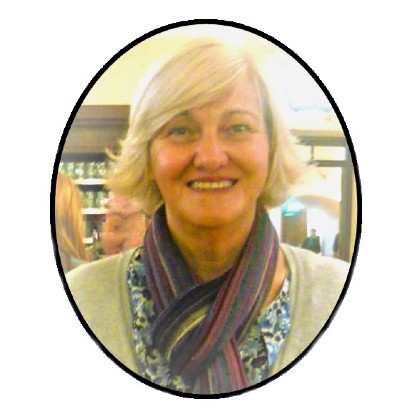
I'm an Australian author and my debut novel, Deadly Secrets is available in both paperback and eBook format. Several of my short stories have recently been published, most notably in the anthology, When Stars Will Shine, and two in The Writers' and Readers' Magazine, Jan 2020 & Oct 2019. Another was previously published in the anthology, Fledglings, by Birdcatcher Books in July 2016. I'm currently polishing my second novel, another political conspiracy mystery/thriller, while the beginnings of a third novel are sitting in the bottom drawer awaiting my attention.
I live in Adelaide, South Australia, although I grew up in country areas near Melbourne. My first degree was a Bachelor of Science, Chemistry, and I have a Graduate Diploma in Education. My long and successful public service career spanned roles as diverse as Management Trainer, Team Facilitator, Statistician and Laboratory Assistant. It gave me insights into the government machine.
In 2011 I decided to seriously pursue my creative writing ambitions. I enrolled in and successfully completed a Graduate Certificate in Creative Writing at Adelaide University. Over the years, I've completed numerous creative writing courses at Writers SA and WEA and once I'd written a first draft I joined a novel-writing writer's group, The Novelist Circle which has a number of published authors.
Besides writing, travelling, and discovering new places, is a passion for me and I have visited many fabulous countries and cities around the world. I keep a daily travel journal and take copious photos and these inspire scenes for my stories e.g. Deadly Secrets begins in Paris and has scenes set in Normandy, Nice and Barcelona before returning to Australia. I am an avid theatre-goer and subscribe to the Adelaide State Theatre company. I enjoy art exhibitions and galleries and of course, I love to read. In March each year, I take full advantage of the Adelaide Writers' festival to discover new authors and to hear my favourites. Some of the writers I admire are Elliot Perlman, Anna Funder, John le Carré and Peter Temple.
You can find out more on my website and on my Facebook page.
Deadly Secrets is available from Amazon (across all their country specific websites), Angus & Robertson, Apple, Barnes & Noble (Nook), and Tolino (via Books 2 Read), Kobo, Barnes and Noble and Book Depository.
I'd like to thank H.R. Kemp for sharing her experiences so openly and in such epic detail. Self-publishing is a long road filled with learning. Reading about author journeys like H.R.'s is both useful and inspiring.
If you have a story you would like to share with my readers, please review my submissions guidelines and then contact me.
Alan D
Many thanks for this, Chris and HR. It’s always helpful to learn how others find these various writing paths, as they can be so deceptive.
Keep safe and well.
Chris Fielden
No problem, thanks Alan :-)
Heather C
Thanks to H.R. for a most comprehensive and revealing review of the process.
I'd love to see a 'Book Club' on YouTube where self published authors could promote by reading (or having read) parts of their books.
Chris Fielden
Nice idea, Heather. I can see that working, especially at the moment when reading events aren't possible. Maybe you should start one?
Eamonn M
The other alternative is a small press publisher. More chance of them taking on a new author and they do the editing and select a cover. They do want you to promote it though. Also, they vary a lot in quality but the good ones are well known.
Chris Fielden
Thanks for that, Eamonn, much appreciated :-)
HR Kemp
Hi Alan D, Heather C and Eamonn M.
I'm glad you found this post useful. Thanks for the comments.
Heather, the idea of an online bookclub sounds good. Indie authors can use all the help we can get to promote our books.
Stay well and keep safe.
Maris M
Thank you for that! It was fascinating and informative. I, too, tried Inkitt and gave up; also Kobo. My first (actually third) novel won a prize and was commercially published, so I still have hopes of attracting the attention of a mainstream publisher. While it didn't have a roaring success, that first book did sell around 2,000 copies here in Australia, which I believe is about average for an unknown author.
With four novels completed plus a collection of short stories I'd really like to get more work out there! It's like having banknotes stuffed under the mattress (sigh).
HR Kemp
Hi Maris. Attracting the attention of a publisher can be tough. Australia is a small market, so good luck.
I always thought I'd be happy to finish a novel and used to say I wasn't aiming to get it published, but somehow, once I'd finished, it seemed such a waste to not have readers. Inkitt helped. My book found readers, and got reviews and comments, but then they also gave me the confidence to self-publish.
Whatever path you take, good luck.
Nick J
This is a fantastic post, HR. I have just bought a Kindle copy of Deadly Secrets now as a thank-you. Have you considered expanding this article into a guide on how to self-publish? Your experience and the learning curve you've had to go through could be the basis for a non-fiction bestseller. Thanks also to you, Chris, for publishing this post, and giving it more exposure. It's a fascinating, and eye-opening, read.
Chris Fielden
No problem, Nick, thanks for your comment - glad you liked HR's post. Great idea about the non-fiction book. I hope that happens :-)
HR Kemp
Thank you, Nick J, I'm glad my guest post was helpful to you and thank you for buying my book. I hope you enjoy it.
On 31 March, Deadly Secrets had its first-year anniversary. It's gone quickly. It's been a big year for many reasons, some obvious, some not, but I've learned that self-publishing is a long-term game. Reviews and sales have been growing steadily and I'm happy to keep learning as I go.
The idea of writing a non-fiction book about self-publishing is interesting. I think there are a lot of books out there, but maybe I'd add a different experience. At the moment I'm trying to finish my second novel (I'm slower than I would like) and I have a third (and even the kernel of an idea for a fourth) waiting, so it will depend on time. I'll keep it in mind though.
Thanks again for your comments and good luck with your ventures.
Nick J
Glad to hear the sales for Deadly Secrets are steadily increasing; you've worked hard for it, and you deserve to succeed. Best of luck with your next project(s)!
JCT M
H R Kemp's article is brilliant. I just wish I had read it before stumbling in to self-publishing!
For many years, I had written for Edward Arnold, Hodder & Stoughton and Hachette. Also I had worked with the BBC and Arts Council in London. Then I became an academic and my writing got left behind!
During lockdown, I self-published for the first time!! I plunged in and had no concept of the issue of online editing / cover design and marketing. That's when H R Kemp's article would have saved me from tearing my hair out and almost throwing my PC out of the window.
So - H R Kemp - thank you for your advice. I have two books due out this year and shall take your advice to heart.
BTW - my ebook on Amazon is called 'Dodgy Dogs and Bent Bookies'. It didn't start out with that title - but it would take a book to tell you the trouble the original title got me into!!
Chris Fielden
Thanks for your comment, JCT. Good luck with your new books. I hope HR's advice helps you, and saves your PC having to learn how to fly :-)
HR Kemp
Thanks for the comment JCT. I hope my post helps with your self-publishing ventures this year and keeps both your hair and the PC safe. I feel as though the learning hasn't stopped for me. Marketing and promotion have taken a lot of my attention over the last year and now I have just published my 11-year-old grandson's book 'The Very Greedy Bear' (a labour of love - he wrote and illustrated it when he was 10, and it won a State School's literary challenge award). Being a picture book, it felt like I was starting from scratch but seeing his face when I presented him with an author copy was priceless. I'm also releasing my next book in April, so I'll be revisiting my own advice.
Good luck with publishing your books.
Leave your comments
Please use the form below to leave your comments. All comments will be reviewed so won't appear on the page instantly. I will not share your details with anyone else. Most recent comments appear at the bottom of the page, oldest at the top.